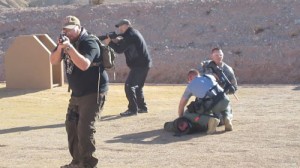
AW2 Veteran Mark Little (front left) secures a quadrant.
By Nathan Nickels, guest blogger from Controlled F.O.R.C.E.
When the Controlled F.O.R.C.E. Team first crossed paths with then enlisted Soldier Mark Little way back in 2004 at the 5th Annual United States National Standards of Training Association (U.S.N.S.T.A.) National Training Conference, he demonstrated a high aptitude for the tactical training that was being conducted. During his initial instructor development training in the Mechanical Advantage Control Holds™ (M.A.C.H.) based system of Close Range Subject Control, Mark showed that he was a quick learner, effective instructor, and determined warrior. These things haven’t changed.
One thing that has changed since then, is that Mark, a former member of the U.S. Army, now operates without real legs. When the Controlled F.O.R.C.E. Team met Mark for the second time, he was back from deployment to Iraq where he sustained major injuries from his third IED attack. As a result of this attack, Mark lost both of his legs.
In July and December of 2008, Mark participated in Controlled F.O.R.C.E. courses. The course instructors Tony Grano and Don Roberts, also developers and directors of Controlled F.O.R.C.E., were surprised to see that Mark retained his agility and spryness despite the fact that he was using prosthetic limbs. At first, because he likes to wear pants not shorts, they didn’t even notice.
Despite prosthetic legs, Mark performs Body Movement Drills, “Mark understands that our training is all about movement,” recalls Grano, “and he showed us that he is still effective at moving his body with prosthetic legs.” At the end of the course, Mark expressed concern to Tony and Don that they might not allow him to continue to the more advanced levels of the system. “The higher levels of Controlled F.O.R.C.E. are designed to instill a dominating, persevering attitude to survive in very close quarters battle,” adds Roberts, “so I don’t see how Mark couldn’t participate in the training.” A few months later, Mark was in the mix of Combative Counter Measures training at the 9th Annual U.S.N.S.T.A. National Training Conference.
In order to commemorate its 10th Annual Tactical Training Conference held at Bally’s Las Vegas on December 14-18, 2009, the U.S.N.S.T.A. utilized the Las Vegas Metro Police Department Tactical Training Facility as part of its 2009 Team Tactics Competition. This competition gave operators from across the military and law enforcement spectrum a chance to test their tactical team movement skills against each other.
Ten teams consisting of four operators each negotiated the training complex with the objective being to neutralize an ongoing hostage situation with armed suspects. Teams were judged on how well they communicated, moved as a team, demonstrated weapon discipline, and performed overall team tactics. Total time was recorded to be used to determine the winner in the event of a tie. Total time, however, was not a factor because there was a clear winner based on the evaluation categories.
Mark served as team leader for a four man squad that included active duty MP Soldiers CPT Matthew Coyne and SSG Ken Grilliot. The precision tactics that they displayed, their purposeful and dynamic movements, and their attention to communication, muzzle control and rear cover, were recognized as the best in a competition of some very good tactical operators.
Mark and his team were named the winners of the competition and acknowledged for their superior performance. “When Mark stood with his team in front of their peers to accept their awards,” says Grano, “he stood as the embodiment of what every member of the Controlled F.O.R.C.E. team strives to be.” A true warrior.
The appearance of external hyperlinks does not constitute endorsement by the United States Department of Defense of the linked web sites, or the information, products or services contained therein. For other than authorized activities such as military exchanges and Morale, Welfare and Recreation (MWR) sites, the United States Department of Defense does not exercise any editorial control over the information you may find at these locations.








